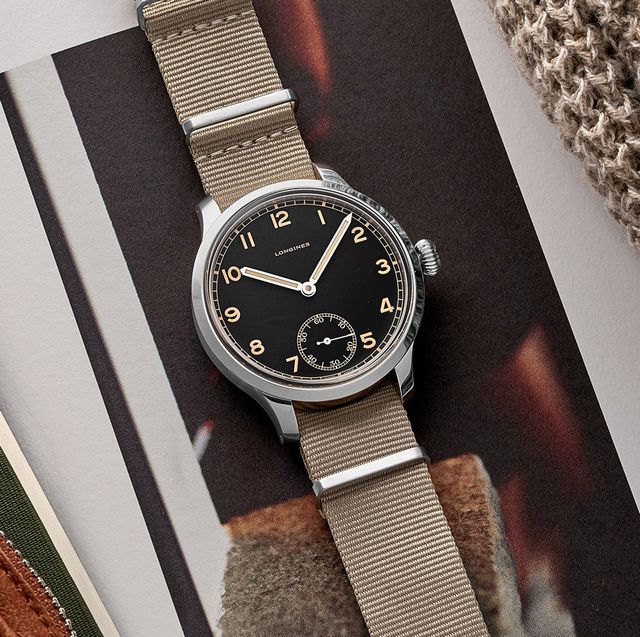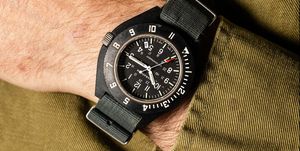Whether or not you know exactly what a NATO strap is, you’ve definitely seen one. A trend item that has aggressively taken hold of the watch industry, NATOs can be found on just about any watch, from $35 Timexes to $9,000 Rolex Submariners to $50,000 Patek Philippes.
Some watch enthusiasts may scoff at the idea of putting a $15 strap on an expensive timepiece, but NATOs are a fun, functional and quickly interchangeable way to show off your watch. While the straps have become fairly ubiquitous, their origin can be traced back to a single point in history.
Where Did the NATO Name Come From?
The answer seems simple: the straps were originally made for NATO troops, right? Interestingly enough, it's thought that the term “NATO strap” came into use as a shortened version of NATO (or National) Stocking Number (NSN), and otherwise has very little to do with the strap carrying its namesake.
Perhaps the more appropriate name for the “NATO” strap is actually the “G10”: In 1973, “Strap, Wrist Watch” made its debut in the British Ministry of Defense Standard (DefStan) 66-15. For soldiers to get their hands on one, they had to fill out a form known as the G1098, or G10 for short. Subsequently, they could retrieve the strap at their unit’s supply store of the same name.
The NATO Strap Was Made to Military Specifications
Though DefStan’s name for the strap was decidedly nondescript, its specifications were distinct and specific. MoD-issued G10 straps were nylon, only made in “Admiralty Grey” with a width of 20mm, and had a chrome-plated brass buckle and keepers. Another key trait was a second, shorter piece of nylon strap attached to the buckle. Since the strap was to be used by the military, it needed to be functional and fail-safe.
The extra nylon had a keeper at its end through which the main part of the strap passed after it had been looped behind the watch. This created a pocket, limiting the distance the case could move. As long as the strap was passed through properly and snugly on the wrist, the case would stay exactly where it was needed. A bonus feature of a strap that passes behind the watch is that in the event that a spring bar breaks or pops out, the case will still be secured by the other spring bar.
The Evolution of the NATO Strap
Since 1973, the G10 strap has seen only slight modification. The current version has been downsized to 18mm (this is due to the 18mm lugs found on the Cabot Watch Company’s military issue watch) and now has stainless steel hardware. In 1978, a company known as Phoenix took over production of MoD-spec G10 straps; those would be the “real deal” if one were looking for them today.
Not long after the simple “Admiralty Grey” G10 was issued, British military regiments began wearing straps honoring their respective regimental colors with stripes of all colors and combinations. One strap’s stripe pattern has become more famous than all the rest, but to call it a G10 or a NATO strap is actually a misnomer.
Enter Style Influencer, James Bond
When Sean Connery’s Bond famously wrist-checked his “Big Crown” reference 6538 Submariner in Goldfinger, he revealed an interestingly striped nylon strap. Aside from being too narrow, the strap was notable because of its navy blue color with red and green stripes. Many watch enthusiasts have labeled this strap as the “Bond NATO.” Despite the strap’s similarities to a NATO, Goldfinger began filming in 1964, nine years before the first MoD G10 strap was issued. Timeline issues aside, it’s clear that the strap Connery wore had a very simple one-piece construction, not unlike that of a waist belt, and distinct from a true NATO.
Despite Bond’s trendsetting strap choice, it would be many years before the nylon strap industry would take hold. Like many other trends born from utilitarian military items (M65 Jackets, camouflage, etc.), early NATO strap adopters were attracted to the item’s usefulness and “tacti-cool” street cred.
Everybody Needs a NATO, or Twelve
The usefulness is still intact, but now that there are literally hundreds of straps of different colors, stripes and materials sold by vendors around the world, it's hardly a matter of street cred anymore. This shouldn’t stop you from wearing one, however. The straps are inexpensive, extremely durable, and can be switched out to fit whatever outfit or mood you’re in. In fact, most watch nerds probably have more NATOs than they do watches.
NATOs had been trending ever upwards over the years, and they don’t appear to be a fad going away anytime soon. NATOs are now fully mainstream. Watchmakers of all stripes now either offer a NATO as an accessory to a watch purchase, or even as a watch's main strap option. The horology purist may scoff at such a thing, but watchmakers would be foolish not to ride the NATO wave; and while they come in varying degrees of quality, a good one is a trustworthy piece of equipment with a rich history.























